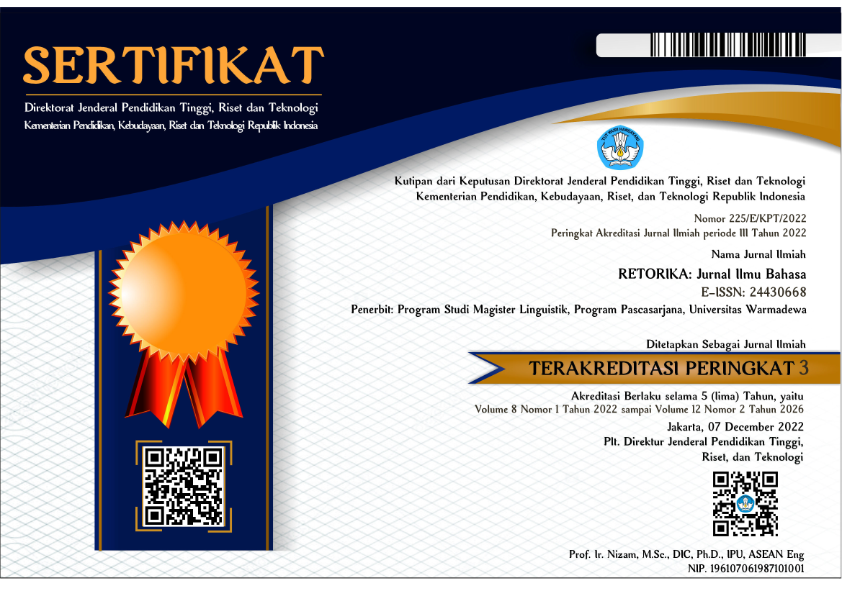Studying Indonesian-Speaking Politeness for Class XI Students at SMK Negeri Tapango, Polman Regency
Abstract
The main problem in this study is how to use the principle of politeness in student interactions and the types of speech acts contained in the interaction of class XI students at SMK Negeri Tapango. This study aims to describe the use of politeness principles and describe the types of speech acts contained in the interaction of class XI students at SMK Negeri Tapango. This research is a qualitative descriptive study with the subject of verbal interaction of class XI students at SMK Negeri Tapango, Polewali Mandar Regency. Data collection techniques used are observation techniques, note-taking techniques and recording techniques. Data analysis techniques by transcribing data from observations, identifying and clarifying data, copying into data cards, analyzing data cards and concluding. The results of this study indicate the number of utterances collected is 35 utterances. The politeness principles include: (1) maxim of wisdom as many as 6 utterances (2) maxim of generosity as much as 8 (3) maxim of appreciation as many as 3 utterances (4) maxim of simplicity as many as 2 utterances (5) maxim of consensus as many as 11 utterances and (6) maxim of sympathy as much as 5 utterances. The maxim that is widely used is the maxim of consensus. The maxim that is widely used is the maxim of consensus. This shows that the speaker and the interlocutor in the interaction maximize the compatibility of goals or opinions in interacting. While the maxim that is least used in the speech of the students of SMK Negeri Tapango is the maxim of simplicity.
References
Aryastini, N.M., Made, N., Anita, A., & Anggraeny, R. 2017. Praanggapan dalam Novel Nijushi no Hitomi Karya Sakae Tsuboi. Humanis, 21(1), 103–109.
Baisu, L. 2015. Praanggapan tindak tutur dalam persidangan di kantor pengadilan negeri kota palu. e-Jurnal Bahasantodea, Volume 3(ISSN : 2302-2000), 129–143.
Chaer, Abdul. 2010. Kesantuanan Berbahasa. Jakarta : Rineka Cipta.
Cummings, Luis. 2007. Pragmatik Sebuah Perspektif Multidisipliner. Yogyakarta: Pustaka Pelajar.
Djajasudarma, Faticvmah. 2010. Wacana Pemahaman dan Hubungan Antarunsur. Bandung: PT. Refika Aditama.
Febriasari, D. 2018. Kesantunan Berbahasa Dalam Proses Pembelajaran Di Sekolah Dasar. KREDO : Jurnal Ilmiah Bahasa dan Sastra, 2(1), 141–156.
Hidayanti. 2015. Analisis Penggunaan Kesantunan Berbahasa Iklan Radio Purbalingga (Kajian Pragmatik). Jornal volume 2. Pragmatik. Yogyakarta: FBS
Indrowaty, S. A. 2015. Praanggapan Dan Perikutan Dalam Bahasa Inggris Dan Bahasa Jepang Presupposition And Entailments. DIGLOSIA, 5(2), 139–146.
Nur, S. 2019. Kesantunan Berbahasa Mahasiswa Pada Pesan WhatsApp Kepada Dosen. Indonesian Language Education and Literature, 5(2), 198–208.
Nurdaniah, Mia. 2014. Prinsip Kesantunan “Berbahasa Menurut Leech Pada Novel Pertemuan Dua Hati Karya N.H Dini Dan Implikasinya Terhadap Pembelajaran Bahasa Indonesia Di SMA. Journal Volume 1. Kesantunan bahasa. Jakarta : FITK
Rahardi, Kunjana. 2005. Pragmatik Kesantunan Imperatif Bahasa Indonesia. Yogyakarta: Penerbit Erlangga.
Safruddin. 2017. Membangun Bahasa Santun. Yogyakarta: Dialektika.
Sugeng, A. D. 2016. Analisis Praanggapan Pada Percakapan Tayangan “Sketsa†Di Trans Tv. BASASTRA, 2(3), 1–16.
Sugiyono. 2012. Metode Penelitian Kuantitatif Kualitatif dan R&D. Bandung: Alfabeta.
Copyright (c) 2023 RETORIKA: Jurnal Ilmu Bahasa

This work is licensed under a Creative Commons Attribution-ShareAlike 4.0 International License.
This journal provides immediate open access to its content on the principle that making research freely available to the public supports a greater global exchange of knowledge.
All articles published Open Access will be immediately and permanently free for everyone to read and download. We are continuously working with our author communities to select the best choice of license options, currently being defined for this journal as follows: Creative Commons-Non Ceomercial-Attribution-ShareAlike (CC BY-NC-SA)
 Abstract viewed = 93 times
Abstract viewed = 93 times
 PDF downloaded = 176 times
PDF downloaded = 176 times

2.png)














